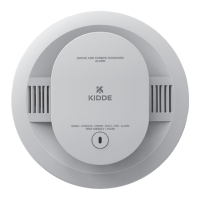16
10. Operation And Testing
Operation
Testing
IMPORTANT: Retail canned smoke products vary by manufacturer and produce inconsistent results. If the unit
does not alarm when canned smoke is applied conduct a push-to-test to verify proper operation. Over-applica-
tion of canned smoke can permanently damage the alarm.
Self-Testing
This model is equipped with internal, self-testing components that are always checking to ensure the device
is operating as expected. (Weekly manual testing is still required. See below.) If the device is not operating as
expected, a fault signal will be generated. (see troubleshooting guide)
Manual Testing
Test your alarm weekly by pressing and releasing the button quickly. A quick beep will confirm the button has
been pushed followed by the test sequence. See Other Alarm Visual and Audible Indicators table. The alarm and
voice will sound if the electronic circuitry, horn, speaker, and batteries are working. If the alarm or voice does not
sound, or gives erratic or low volume sound, the unit must be replaced.
WARNING: DUE TO THE LOUDNESS OF THE ALARM, ALWAYS STAND ABOUT 2.5 FEET AWAY
FROM THE UNIT OR USE EAR PROTECTION WHEN TESTING.
WARNING: DO NOT USE AN OPEN FLAME TO TEST YOUR ALARM, YOU COULD DAMAGE THE
ALARM OR IGNITE COMBUSTIBLE MATERIALS AND START A STRUCTURE FIRE.
Chirping
When End of Unit Life or Low Battery chirping begins, you can temporarily silence these chirps by pressing
the button.
WARNING: REPLACE UNIT AS SOON AS POSSIBLE WHEN IN END OF UNIT LIFE.
CO ALARM SENSOR RESPONSE TIMES
At 70 PPM, the unit must alarm within 60-240 minutes.
At 150 PPM, the unit must alarm within 10-50 minutes.
At 400 PPM, the unit must alarm within 4-15 minutes.
The alarm is operating once it is activated and
testing is complete (see “TESTING” below). When
products of combustion (smoke or CO) are sensed,
the unit sounds a loud alarm with voice messages.
See Sections 1 and 2 for alarm signal descriptions.
In high levels of CO, the unit will go into alarm in a
shorter period of time than at low levels of CO.

